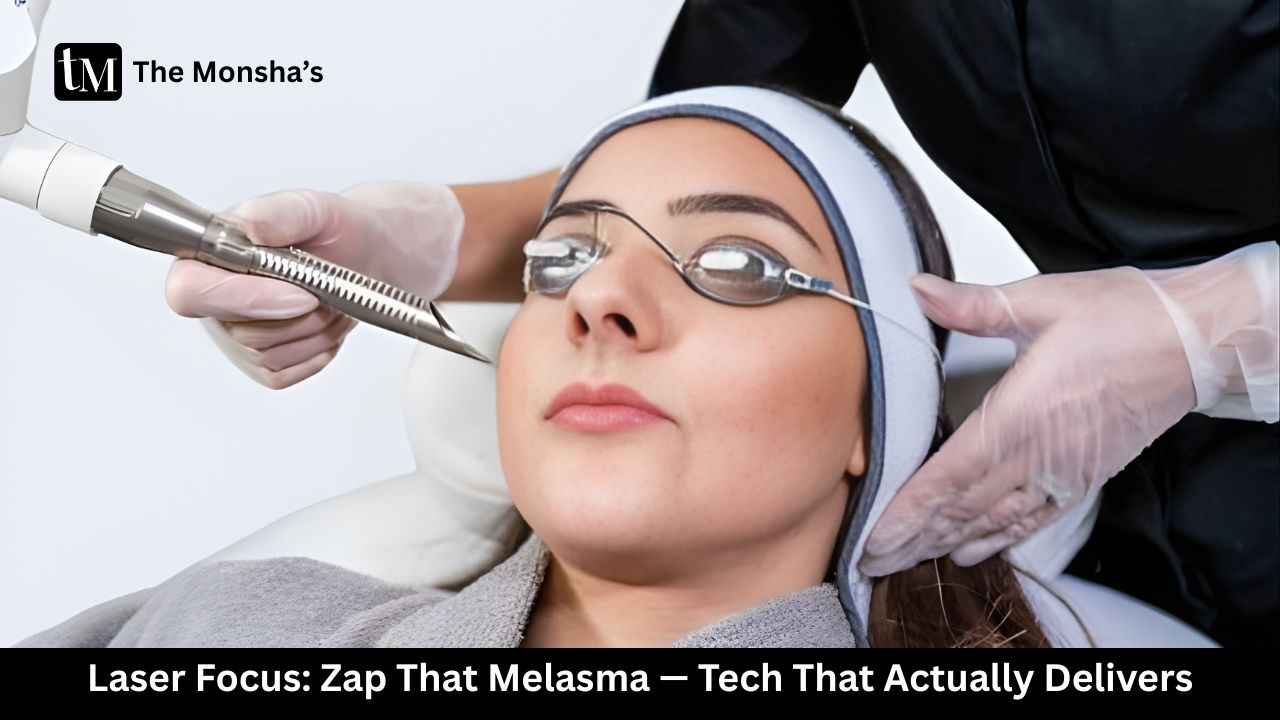“Melasma ka naam sunte hi lagta hai jaise koi saaya chipak gaya ho… cream lagao, sunscreen lagao, fir bhi wohi brown patches. 🎵“Laser lagake hum tumhe… bhool na paayenge” — bas yeh glow ka remix hai!” 😅
TL;DR — Lasers Can Be Game-Changing for Melasma, But Only If Done Right
- Melasma = stubborn pigmentation triggered by hormones, sun, heat
- Modern lasers target pigment gently (low-fluence, picosecond, hybrid)
- Wrong settings or unqualified hands = flare ups or worse pigmentation
- Combine lasers with strict sun care + maintenance topicals for best results
- Always choose a clinic with experience in melasma & dark skin tones
What Is Melasma & Why It’s So Stubborn
Melasma is a chronic hyperpigmentation disorder that often shows up as brownish patches on cheeks, forehead and upper lip. Think of it as a clingy guest who arrived during pregnancy or after years of sun exposure — and just won’t leave. It’s more common in women and in Indian skin tones (Fitzpatrick IV–V), which are also more prone to post-inflammatory hyperpigmentation (PIH). This is why your average “brightening facial” rarely works.
How Lasers Treat Pigmentation — The Science Behind the Glow
Lasers work on the principle of selective photothermolysis — firing light of specific wavelengths to break melanin into tiny fragments so your body can clear it. But here’s the catch: melasma is heat-sensitive. Too much energy = rebound pigmentation.
Dermatologists now prefer low-fluence (gentle energy) settings and new pulse technologies like picosecond lasers which use pressure instead of heat. This reduces risk of PIH and still fades pigment.
Laser Technologies for Melasma — A Deep Dive
Below are the main players in the laser arsenal, along with pros, cons, and the latest upgrades.
Q-Switched Nd:YAG (Low-Fluence)
- Gold standard for Indian skin; targets deeper pigment with minimal surface trauma
- Works best when done in multiple sessions at low energy
- Newer devices offer better cooling & spot size adjustments to reduce heat
Picosecond Lasers (Ultra-Short Pulse)
- Deliver energy in trillionths of a second — less heat, more shattering of pigment
- Brands like PicoWay or piQo4 combine wavelengths for both epidermal and dermal pigment
- Studies show fewer sessions needed, less downtime, and less rebound compared to older Q-switch alone
Fractional / Hybrid Lasers
- Non-ablative fractional lasers create micro-channels that boost skin turnover
- Often combined with topical agents or other lasers in “stacked” protocols
- Caution: must be gentle for melasma, otherwise can worsen pigmentation
Emerging Tech (Neo Elite, 650-Microsecond Pulse, Laser Stacking)
- Newer “cold” lasers like Aerolase Neo Elite use long wavelengths and ultra-short pulses to bypass melanin safely
- “Laser stacking” (using two or more lasers sequentially) can improve outcomes when done by experts, but increases cost and requires skill
Choosing the Right Laser — Factors & Decision Matrix
Here’s a quick cheat sheet:


Risks, Side Effects & What Can Go Wrong
Let’s keep it 100% real: lasers are not magic wands.
Potential pitfalls:
- Post-inflammatory hyperpigmentation (PIH) if energy too high
- Hypopigmentation (white spots) if melanin destroyed unevenly
- Scarring or burns with wrong technique
- Rebound melasma if aftercare neglected
Safety tips: always do a patch test, avoid sun for at least a week post-session, and use a broad-spectrum tinted sunscreen daily.
Smart Protocols: “Laser +” Approach for Best Results
Top derms rarely use lasers alone. They combine:
- Topicals: tranexamic acid, azelaic acid, kojic acid (post-laser maintenance)
- Peels or microneedling: gentle versions only
- Sun protection: hats, umbrellas, tinted sunscreens (SPF 50+)
- Maintenance schedule: touch-up sessions every few months if needed
Real-life example: A 35-year-old Indian woman achieved >70% pigment reduction with low-fluence Nd:YAG + topical tranexamic acid over 6 months — no PIH.
Case Stories That Inspire
Patient diaries can be powerful:
- One client shared she’d tried hydroquinone for years with minimal change. After 5 low-fluence sessions + strict SPF, she finally saw patches fade without flare-ups.
- Another combined picosecond laser with oral antioxidants and got smoother, more even skin with less downtime.
What To Ask Your Dermatologist / Laser Clinic
- Which laser & settings for my skin type?
- How many sessions & spacing?
- What aftercare do you recommend?
- Do you have before/after photos of melasma on similar skin tones?
- What’s the maintenance plan to prevent relapse?
If the clinic promises “one session cure” or “no patch test needed” — run. 🏃♀️
FAQs — Glow Gurukul 💡
Q1. Can laser completely remove melasma?
No — it significantly lightens but melasma can recur without maintenance.
Q2. How many sessions will I need?
Usually 4–8 sessions at 3–4 week intervals, but varies by skin & depth.
Q3. Is laser painful?
Most describe it as warm snaps; cooling devices & numbing creams help.
Q4. Will melasma come back?
Possible — hormones & sun can trigger it again, so aftercare is key.
Q5. Can pregnant or breastfeeding women get laser?
Generally not recommended; consult your dermatologist.
Conclusion: The Melasma Gyaan Recap
Lasers can be life-changing for stubborn melasma — but only with the right device, right settings, and right hands. Combine it with diligent aftercare, sun protection, and maintenance topicals for the glow you deserve.
“Na cream, na conceal… laser hi kare deal!” 😎
📞 Want dermatologist-approved treatments at home? Book your glow ritual with The Monsha’s – Salon at Home Services today.Visit www.themonshas.com or call 9599470951 to bring pro skincare right to your doorstep.


